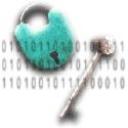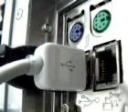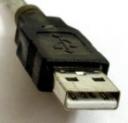 If you happen to be a small or medium scale company that cannot afford multiple data stores and infinite numbers of mirrored hard drives, that becomes a problem. An encrypted hard disk in a laptop that gets banged up damaging the hard disk may still have some of the information intact enough for recovery but damage some of the vital keys and software and you are left hanging by a thread or down in the gutters. Data recovery is possible but only through expensive methods with the hard disks being opened up, the platters extracted and installed into another similar hard disk for data extraction. Only the military and federal government would have enough cash to burn in terms of data recovery at that level for the price is computed in the amount of megabytes recovered and on a per hard disk basis, and imagine a 1 terabyte drive at say $50/MB then you’d be scratching your head by now, and that’s just for a single drive.
If you happen to be a small or medium scale company that cannot afford multiple data stores and infinite numbers of mirrored hard drives, that becomes a problem. An encrypted hard disk in a laptop that gets banged up damaging the hard disk may still have some of the information intact enough for recovery but damage some of the vital keys and software and you are left hanging by a thread or down in the gutters. Data recovery is possible but only through expensive methods with the hard disks being opened up, the platters extracted and installed into another similar hard disk for data extraction. Only the military and federal government would have enough cash to burn in terms of data recovery at that level for the price is computed in the amount of megabytes recovered and on a per hard disk basis, and imagine a 1 terabyte drive at say $50/MB then you’d be scratching your head by now, and that’s just for a single drive.
The risks of identity theft and information leakage is real but the technology is still quite prone to failure even with today’s quad-core which is why we didn’t discuss the performance issue in the discussion. Today’s multi-core processors are capable of handling complex tasks such as real time encryption and decryption as if there was nothing happening on the background. The performance issue has been addressed by more powerful microprocessors but the reliability of the hard disks which stores the information and even the CD’s are still quite weak. Till there is more definite proof that all parts of the computer has reached such a reliable level that failure is a less of a factor more people would still retain their own proprietary security measures (birthday passwords, flash thumb drives that always get lost and physically carrying their discs with them).
Encryption – Why people shun away from it even now? (Part 1)
 Encryption used to be the mainstay of military and other government agencies who need to secure the information they handled preventing anybody who may get access rendering the information useless. Everybody knows about it yet not many use it for the protection of their vital information stores, why? Well there are a hundred reasons why people mistrusts such an extreme measure as encrypting data and one is reliability of technology on which it is used on. Computers as we know have become cheaper and cheaper that has been good on one side but it also raises the risk of failure due to cheaper parts and higher risk for data loss due to failure. I know a lot of people would be going against me on this one but if you have experienced a hard disk crash during my many years of computer use and association with them in my previous line of work as a technical support supervisor, you’d know what I mean.
Encryption used to be the mainstay of military and other government agencies who need to secure the information they handled preventing anybody who may get access rendering the information useless. Everybody knows about it yet not many use it for the protection of their vital information stores, why? Well there are a hundred reasons why people mistrusts such an extreme measure as encrypting data and one is reliability of technology on which it is used on. Computers as we know have become cheaper and cheaper that has been good on one side but it also raises the risk of failure due to cheaper parts and higher risk for data loss due to failure. I know a lot of people would be going against me on this one but if you have experienced a hard disk crash during my many years of computer use and association with them in my previous line of work as a technical support supervisor, you’d know what I mean.
The technology we have today is of the highest level of quality and technological complexity of the computers I started to work with (386’s and 486’s) but the robustness of these gadgets and gizmos we call peripherals are still quite low except for the extreme types that are too expensive for the ordinary user to afford. Imagine a failed motherboard that has fried circuits, no problem for the hard disks are seldom affected by such incidents. Get the board out and swap it out and you connect the hard disk and you have your data available. Imagine you have a failure in the hard drive itself; you get some software and try to recover that information hoping you get enough of the sensitive files your boss needs in the morning. Now, imagine having a hard disk that was encrypted and had some of its sectors rendered useless, now that’s a nightmare for the encrypted data is useless with the key and the code stored into the hard disk itself.
Government Laptops and Computers get encrypted
 Due to the recent problems associated with the loss of government laptops and security breaches such as the incident where the laptop of a Federal Trade Official was reported to have been compromised by reportedly Chinese operatives while on a trip overseas, the US Federal government has begun to encrypt their laptops in hopes of bolstering their security to prevent such security risks in the future. Let us just hope that they do it fast enough for no one wants to get their personal and financial information released online or obtained by enemies of the state (terrorists in layman’s terms). Of the estimated 2 million laptops the US government and the many agencies have, only 800,000 have had the encryption system developed by the Department of Defense and the General Services Administration.
Due to the recent problems associated with the loss of government laptops and security breaches such as the incident where the laptop of a Federal Trade Official was reported to have been compromised by reportedly Chinese operatives while on a trip overseas, the US Federal government has begun to encrypt their laptops in hopes of bolstering their security to prevent such security risks in the future. Let us just hope that they do it fast enough for no one wants to get their personal and financial information released online or obtained by enemies of the state (terrorists in layman’s terms). Of the estimated 2 million laptops the US government and the many agencies have, only 800,000 have had the encryption system developed by the Department of Defense and the General Services Administration.
Encryption is one of the most secure way pf keeping data safe from unauthorized access which renders them useless without the proper software or security keys. Comparable to the dial combination on a bank vault, the encryption process turns files onto a useless bundle of information that cannot be read or used for other purposes.
All this effort to boost security of information that is gathered and collated by the various agencies and even private businesses that have ties with the government though contracts have had their computers encrypted to ensure the information they handle and use stays secure and out of the hands of criminals who aim to use them against the government.
Encrypted Hard Disks – Data Secure —Naaaahhhh!!!!
 As the evolution of the lowly hard drive goes with the increase of storage capacity into the terabyte range and hardware based-encryption it seems that data cannot be more secure once it is stored within the said hard disk. Well, according to WindowsIt Pro, not totally for based on their testing of several hard drives that come as wireless removable storage devices you connect to your USB 2.0 ports, it ain’t that secure after all. The device/s tested was even secured by a wireless security key that used rfid technology to unlock the drive for use by authorized users only (which in the real world is anyone who has the keychain key).
As the evolution of the lowly hard drive goes with the increase of storage capacity into the terabyte range and hardware based-encryption it seems that data cannot be more secure once it is stored within the said hard disk. Well, according to WindowsIt Pro, not totally for based on their testing of several hard drives that come as wireless removable storage devices you connect to your USB 2.0 ports, it ain’t that secure after all. The device/s tested was even secured by a wireless security key that used rfid technology to unlock the drive for use by authorized users only (which in the real world is anyone who has the keychain key).
The name and brand which we would not name for obvious reasons have indeed admitted the weakness and that the advertised capability of the drive was wrong. As it turns out, the true 128-bit AES security system was used only by the RF chip and the controller on the drive which was easily defeated by removing the drive from the case and connecting to a now standard SATA drive connector. The drive was encrypted, but not at the ‘military grade’ levels that were advertised for the encryption chip used only a basic encryption level which was not up to par with accepted high-encryption standards.
Both the manufacturers of the controller boards, casing and key, have acknowledged the flaw and promise a more robust system (which is to use a more secure encryption chip that is said to come out this year but is still only in development) by the end of the year. So we guess the false advertising with regards to the encryption standard of the drives should be changed from ‘Strong 128-bit AES encryption’ to ‘standard encryption’, which would only be fair for people do make choices based on the products qualities and capabilities.
IP-Based Security Surveillance ( Part -1 )

Security cameras in its many shapes and forms have evolved into more of a necessity rather than a luxury usually available to those firms who could afford it. Developments in CCD technology and miniaturization of electronics components have allowed the price to fall steady making them widely available and easy to deploy. Similar to webcams, IP based security systems like the one from LPM, are now more and more becoming well accepted for like VoIP, it allows the video feed from a site hundreds of miles away to be sent over the internet to a security center in the company’s security center allowing centralized monitoring of warehouses and other facilities that would otherwise need security personnel saving in manpower costs.
The technology has evolved to a point that all one needs for IP-based security surveillance monitoring is a peripheral card one installs into the standard PC and the necessary cameras that are desired. Another deterrent of security systems of past was the requirement for extensive cabling which can be quite costly if one wishes to monitor a large area which needs to have all supporting cabling installed (power, video feed cables, audio cables, etc.). The advent of the many wireless radio communication technologies have also contributed to ease of implementation allowing wireless communication between a site’s central console and it’s subordinate cameras, who then send the information through the internet to it’s security base which can be a few blocs to hundreds of miles away.
[tags]Security Systems, Video Surveillance, Remote Security Systems, Asset Protection [/tags]
That darned USB port!

 USB has been around for quite sometime and was designed to replace the interface capabilities of the old legacy standard. Today, most PC’s, Laptops and other peripherals have USB ports or have the capability of connecting to one such as keyboards, mice, digitizing pads, digital camera’s, video camera’s, flash disks and the device types goes on and on. They have become so common that many security experts warnings on their danger have gone unheeded, till now that is. Recent security holes and other problems associated with malware and viruses that have been transmitted through the USB port have risen to the point security people had to listen. These interface ports are quite convenient and easy to use that even the most beginner can plug an infected device such as a flash disk loaded with malware or viruses that they easily get through standard security. They are so small that physically banning them can be next to impossible and I’m sure you’ve read the several articles regarding the iPod which was connected to the corporate network…etc. Expert’s advice that to minimize their use for no good, disable them on-board or do not bother connecting them at all at the hardware level. This would render them truly unusable for some people however innocent of the workings of a PC or other computer type can enable them in the control panel easily. Unbeknownst to many, most devices that have flash memory can be used to store files other than video or pictures for they can be formatted using the operating system’s format utility or the propriety software such as iPod’s iTunes which can have even the most basic iPod Shuffle function as a flash disk allowing transport of say documents and other such files.
USB has been around for quite sometime and was designed to replace the interface capabilities of the old legacy standard. Today, most PC’s, Laptops and other peripherals have USB ports or have the capability of connecting to one such as keyboards, mice, digitizing pads, digital camera’s, video camera’s, flash disks and the device types goes on and on. They have become so common that many security experts warnings on their danger have gone unheeded, till now that is. Recent security holes and other problems associated with malware and viruses that have been transmitted through the USB port have risen to the point security people had to listen. These interface ports are quite convenient and easy to use that even the most beginner can plug an infected device such as a flash disk loaded with malware or viruses that they easily get through standard security. They are so small that physically banning them can be next to impossible and I’m sure you’ve read the several articles regarding the iPod which was connected to the corporate network…etc. Expert’s advice that to minimize their use for no good, disable them on-board or do not bother connecting them at all at the hardware level. This would render them truly unusable for some people however innocent of the workings of a PC or other computer type can enable them in the control panel easily. Unbeknownst to many, most devices that have flash memory can be used to store files other than video or pictures for they can be formatted using the operating system’s format utility or the propriety software such as iPod’s iTunes which can have even the most basic iPod Shuffle function as a flash disk allowing transport of say documents and other such files.